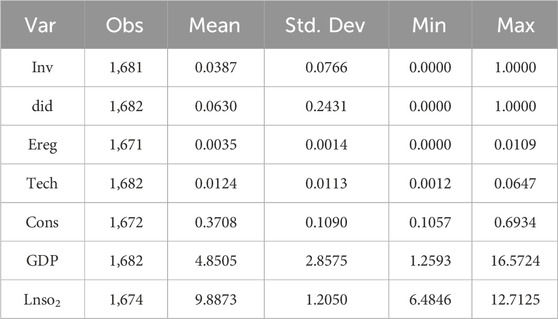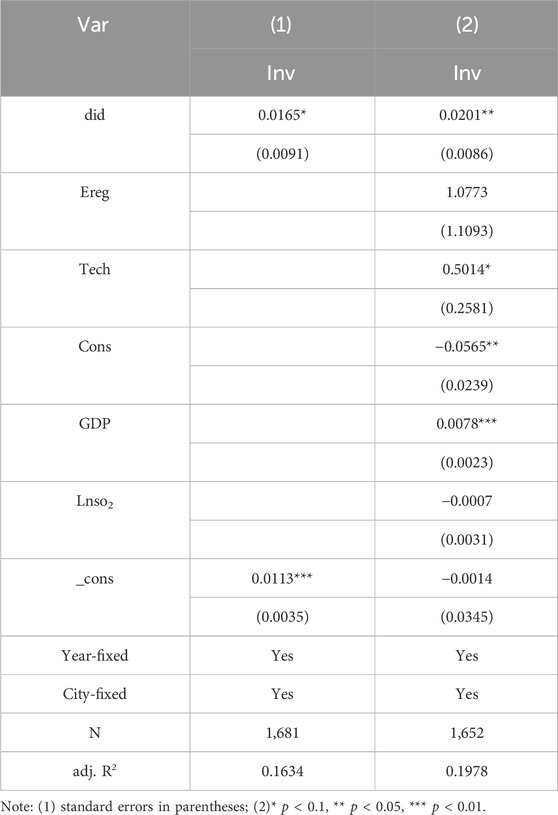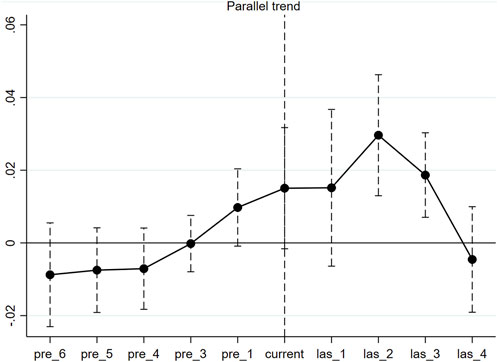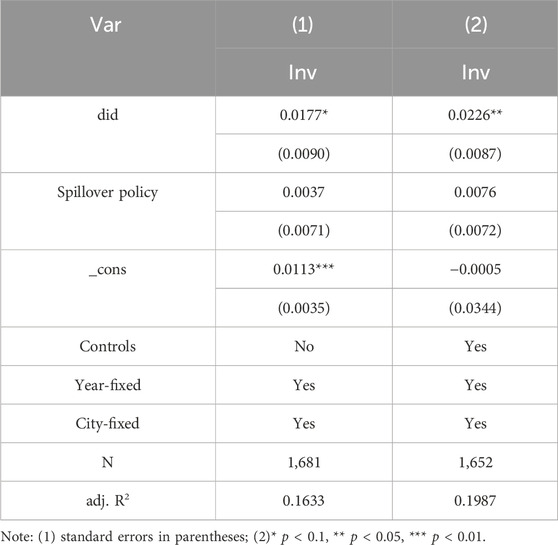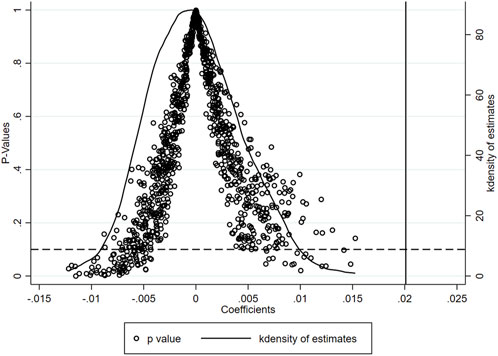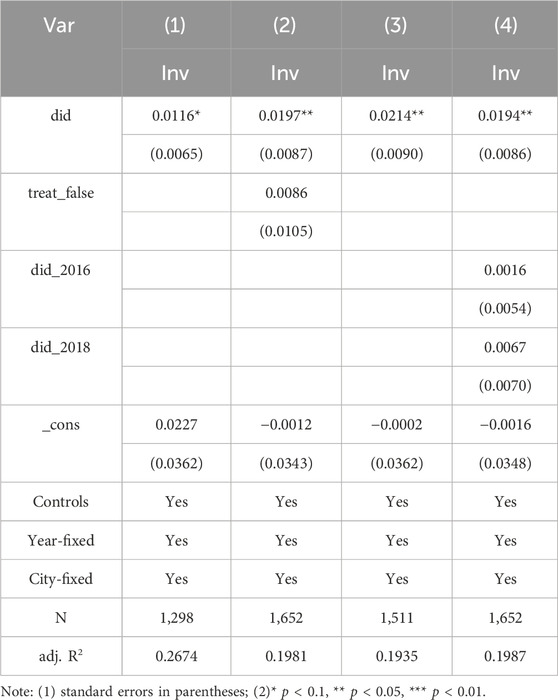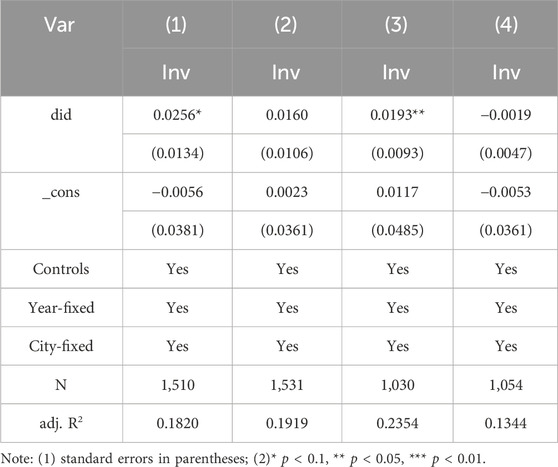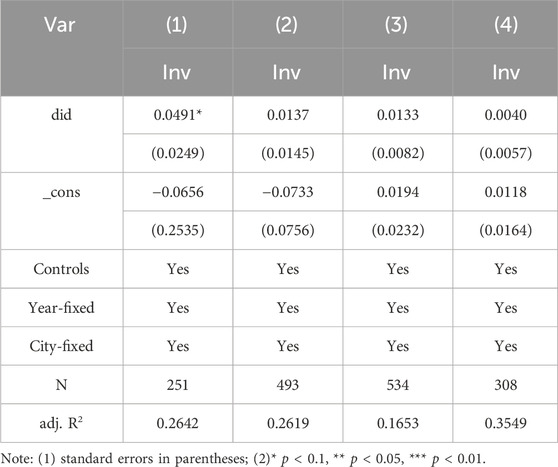- 1School of Humanities and Social Sciences, Jiangsu University of Science and Technology, Zhenjiang, Jiangsu, China
- 2School of Economics and Management, Gannan University of Science and Technology, Ganzhou, Jiangxi, China
Introduction: With industrial transformation and upgrading being essential to attaining sustainable growth, the pursuit of green development has grown in importance on a global scale.
Methods: This study employs a sample dataset from 2011 to 2021, utilizing the national Industrial Transformation and Upgrading Zones (ITUZ) policy interventions of 2017 and 2019 as a quasi-natural experiment. Employing a difference-in-differences approach, this paper investigates the impact and underlying mechanisms of these policies on green technology innovation, as well as their heterogeneity across different urban contexts.
Results: The results indicate that the ITUZ policy substantially improves green technology innovation in the designated cities, a conclusion that persists across multiple robustness assessments. Subsequent mechanistic research reveals that financial development and the enhancement of industrial structures are essential avenues for the realization of green technology innovation. The heterogeneity study highlights the policy’s significant impact on green technology innovation in eastern cities, uniform demonstration zones, and old industrial cities.
Discussion: This study finishes with practical implications for policy design, indicating that it is essential to extract and share the beneficial experiences from pilot cities during the establishment of demonstration zones. It underscores the importance of synchronizing urban development policies with local characteristics to investigate varied and successful approaches for advancing green technology innovation. This research offers critical insights for policymakers and urban planners in guiding the transition of older industrial and resource-based cities toward a more sustainable and environmentally friendly future.
1 Introduction
In the context of carbon neutrality, environmental issues have received heightened worldwide attention, and the notion of green development has arisen as a collective aspiration among countries. The degradation of the natural environment undermines residential quality and presents a substantial risk to the long-term viability of urban development (Chen et al., 2024; Guo et al., 2024c; Khan et al., 2022). The Lancet analysis suggests that global pollution-related fatalities from 2021 will continue to hover around 8.5 million, with a slight decrease. The GBD 2021 reports that environmental conditions in China resulted in 1.8 million deaths in 2021. Moreover, as asserted by Fuller et al. (2022), the increased mortality rate is primarily due to air pollution and harmful chemical exposure stemming from industrialization and urbanization, especially in emerging nations. Simultaneously, the IEA 2022 research reveals that China’s overall carbon emissions account for almost 32% of the global total. Indeed, environmental problems endanger human health (Guo et al., 2024a). The emergence of green technology innovation provides a scientific and technological basis for pollution mitigation and resource conservation, which is essential for promoting sustainable economic growth. Green technology innovation refers to technological advancements that incorporate economic advantages alongside environmental considerations (Chen et al., 2024; Zhou and Wang, 2022). Examining the driving forces behind green technological innovation and augmenting the capability for such innovation have become critical topics in the current study. Currently, numerous scholars are investigating the determinants that affect the advancement of green technology innovation, emphasizing both enterprise and policy dimensions. The key determinants affecting enterprise-level green technology innovation comprise financial performance (Li et al., 2017), capital investment (Jiang et al., 2021), external financing limitations (Wang et al., 2022; Zhang et al., 2023), and corporate organizational competencies (Garcia-Quevedo et al., 2022). The principal elements influencing policy are governmental support (Lai et al., 2022), governmental regulation (Cheng and Yu, 2023), and financial policies (Chen et al., 2022).
Innovation is crucial to economic growth and green development, yet enterprises typically lack the incentives to implement green technical advancements independently. High-risk, high-investment, and public goods characterize such breakthroughs (Wang et al., 2022). Countries around the world are focusing more on the role of government in promoting innovation ecosystems to incentivize corporations to innovate. Cities are key players in national innovation systems because they drive economic and social growth and store advanced innovation resources. The EU has proposed the Strategic Plan 2019–2024, called the “European version of the Five-Year Plan.” Industrial policy has been highlighted as a key component for the first time, and public subsidies for science, technology, and innovation have increased. The UK and London governments’ “Tech City” effort has helped London become Europe’s greatest innovation hub.
Since the reform and opening up, significant progress has been observed in both the economy and society. The limitations on economic and social development due to insufficient innovation capacity are increasingly apparent, especially in older industrial cities and resource-based urban centers. The majority of old industrial and resource-based cities exhibit limited economic diversity and resource scarcity, facing the dual challenges of the “resource curse” and “path lock” (Guo et al., 2024b; Sun et al., 2024). Given the current global context, characterized by heightened competition in scientific and technological advancement, China has established the strategic goal of emerging as a significant science and technology powerhouse to promote sustainable development. To effectively implement the innovation-driven development strategy, China has launched various policy experiments targeted at specific locations, such as the Smart Cities project, the Made in China 2025 initiative, and the Industrial Policy Upgrading Demonstration Zones (Guo et al., 2024b). Smart cities focus on improving residents’ quality of life and optimizing urban green economies by integrating advanced technologies and employing data-driven decision-making and operations (Chen et al., 2024). The pilot policy, Made in China 2025, addresses the planning, construction, and governance of the manufacturing sector (Wen and Zhao, 2021). The policy of the Industrial Transformation and Upgrading Demonstration Zones pertains to the government’s support for cities within the zones to implement industrial transformation and promote green development. The aim is to transform the pilot cities into hubs of exceptional scientific and technological support and leadership. The guidance clearly states that localities must increase their investment in innovation and create a conducive environment for innovation. The policy contents highlight the importance of green development in urban transformation and the increased focus of local officials on green technological innovation. This integrates innovation and provides strong solutions and technical support for regional environmental protection and governance. This acts as an internal catalyst for the transformation of economic development (Sohag et al., 2019). The principles and objectives of the ITUZ focus primarily on industrial transformation and upgrading. This will require advancements in green innovation, which will increasingly influence the development of green technology. Consequently, it is essential to perform a comprehensive analysis of the relationship and mechanisms connecting ITUZ and green technology innovation.
The objective of this research is to establish models that will assess the potential influence of ITUZ on green technology innovation. This study offers three possible contributions. This study integrates economic and environmental benefits within a framework, focusing on urban development to assess the effectiveness of a place-based industrial strategy (ITUZ) on green technology innovation in old industrial and resource-dependent cities. Secondly, we employ a model that depicts the influence of ITUZ on green technology innovation, integrating the moderating effects of financial development and enhancing industrial structures. This study examines the varied impacts of ITUZ on green technology innovation, taking into account the distinct characteristics of demonstration zones, urban historical traits, and locations. The diverse typology of cities serves as a crucial reference for formulating industrial policy and advancing green technology innovation.
This study is organized as follows: the second section covers the literature review and research hypotheses, the third section encompasses the model and data, and the fourth section elucidates the empirical results and discussion. The fifth section delineates the results and ramifications, while the final section identifies research gaps and future directions.
2 Literature review and theoretical hypotheses
2.1 Place-based industrial policy and ITUZ
A place-based industrial policy is designed to encourage the growth of a particular area. To do this, the government may employ diverse financial and tax policy incentives, together with the benefits of regional resource endowments. The objective of this policy is to foster the superior development of industries within the specified region. In industrialized nations, the principal aims of location-focused industrial policies are to rejuvenate economically distressed areas, generate job opportunities, and foster equitable socioeconomic development (Ashenfelter and Card, 2010; Duranton et al., 2015). Conversely, in developing nations, such measures are generally prioritized in places that are more geographically or economically advantageous. The economic advancement of these regions, thus, fosters the overall economic development of the nation. Although the aims of location-oriented industrial strategies are commendable, their real impacts are still debated. Certain researchers assert that location-specific industrial policy can enhance regional company R&D investment (Wen and Zhao, 2021), technological innovation, and industrial advancement via factor agglomeration and spatial spillover effects. Moreover, these regulations can promote the reduction of carbon emissions and improve the quality of the area’s ecological environment (Wang et al., 2023). In contrast, several academics have shown that location-specific industrial strategies at lower levels are more vulnerable to the competitive dynamics of the local economy, resulting in a decrease in innovation factor inputs. This is primarily due to the rise in environmental governance expenses, which in turn leads to a decrease in R&D investments (Cai et al., 2021). In conclusion, there is a scarcity of empirical evidence and a lack of agreement concerning the macro-innovation effects of place-based industrial policy. The ITUZ program signifies a substantial endeavor to facilitate the economic transformation of China’s old industrial and resource-based urban areas. Given the aforementioned constraints, the ITUZ policy research undertaken in this study enhances the current evidence base for evaluating place-based industrial policies.
Regarding ITUZ, only a few researchers have undertaken pertinent studies on its environmental effects due to its relatively recent inception. Guo et al. (2024b) present an instance of evaluating and analyzing the environmental ramifications of the policy. The research indicated that the ITUZ strategy significantly decreased energy consumption in resource-based and old industrial cities from 2010 to 2021, mainly by optimizing industrial structures and enhancing green innovation. Moreover, the results indicate that market-oriented changes may amplify this energy-saving benefit. Xue Fei’s research concludes that ITUZ facilitates a decrease in regional carbon emissions (Xue et al., 2023). The existing study lacks conclusiveness concerning the effects of location-specific industrial policy on urban green technological innovation and its underlying mechanisms. The absence of clarity hinders the establishment of a comprehensive innovation policy framework in China.
2.2 ITUZ and green technology innovation
The government has a significant impact on the development of green technology, and the policy environment is critical in this process (Wu et al., 2022; Yu and Cai, 2021). There are two kinds of guiding policies for green technology progress. One is the general policy, which includes government subsidy policy (Aerts and Schmidt, 2008), government support policy (Chen and Li, 2023; Doh and Kim, 2014), and environmental information disclosure policy (Feng et al., 2024). Another pilot initiative is the carbon emissions trading pilot policy (Fu et al., 2023), in conjunction with the energy usage rights trading policy and the smart city pilot policy. Wang et al. (2024) assert that green technology innovation under the pilot energy usage rights trading scheme serves as a crucial mechanism for advancing urban pollution mitigation and carbon reduction. Unlike these pilot programs, ITUZ prioritizes geographical orientation and industry transformation and upgrading, providing a unique avenue for green technology innovation. Nonetheless, there is a scarcity of study on ITUZ, especially concerning its influence on green technology innovation, which can be categorized as a national macro-level policy component. ITUZ is a policy framework established by the Chinese government aimed at enhancing the industrial structure of old industrial cities and resource-based cities. The protracted evolution of these cities has led to several detrimental outcomes, including resource depletion, environmental pollution, and ecological destruction. These challenges are collectively referred to as “resource curses,” which have ultimately resulted in the issue of “path-locking” in industrial progress (Sun et al., 2024). The aim of this policy is to identify and utilize the comparative advantages of various regions, promote the rational distribution of resources and the effective development of industries, improve the competitiveness of the regional economy, expedite the modernization and transformation of traditional industries, and ultimately foster green technological innovation. Since the national ITUZ strategy was put into place, each demonstration zones have carefully looked at and made the most of its unique regional advantages. They have also looked at industrial transformation strategies that fit the specifics of their area. Given the aforementioned developments, the demonstration zones have successfully acquired significant people and capital resources from state ministries and commissions through policy implementation. The government intends to strengthen its support for the demonstration zones in areas such as industrial, innovative, investment, financial, and land policy. The objective is to create a sustainable support framework by instituting an annual evaluation system alongside a system of incentives and penalties. An examination of the pertinent literature indicates that the effective execution of this policy has produced significant results in green development, improved the innovative input and output capacities of enterprises, and markedly refined the local industrial structure (Xue et al., 2023). Simultaneously, the demonstration zones promote the comprehensive integration of digital technology across many economic, social, and industrial development sectors. It additionally advocates for the global implementation of sophisticated energy-efficient and low-carbon technologies, apparatus, and management practices. Moreover, it promotes the sustainable transformation of the energy resources sector and thoroughly enhances the economic and industrial frameworks.
2.3 Theoretical analysis and research hypotheses
The National Development and Reform Commission (NDRC), along with five other ministries, has collaboratively released a series of policy documents to enhance industrial structure optimization and promote environmentally sustainable development. These policy documents demonstrate the government’s profound commitment to the green transformation of industry while fostering innovation through policy incentives and year-end evaluation systems. The policy evaluates the success of demonstration zones using an annual assessment procedure. Demonstration zones exhibiting exceptional performance will get comprehensive support from central financial authorities, encompassing critical components such as budgetary allocations, pilot funding for reform and innovation, and land resources. This positive incentive not only supplies the demonstration zones with essential resources but also serves as a robust motivator for further innovation. Conversely, localities that receive inadequate evaluations for two consecutive years may forfeit their designation as demonstration zones and the associated policy assistance upon formal notification and censure. This restrictive approach guarantees the efficacy of the programs inside the demonstration zones and offers institutional protections for robust competition among cities. Upon further analysis, the beneficial effects of the demonstration zones policy for green technology innovation are primarily evident in the following areas: the execution of the demonstration zones strategy fosters the advancement of enterprises toward greater environmental sustainability and reduced resource dependency. The policy curtails the growth of conventional high-pollution and high-energy-consumption industries, directing firms to enhance research and development (R&D) in green technology, thus optimizing and upgrading the industrial structure (Yang et al., 2020). This approach mitigates environmental contamination while fostering resource efficiency and the advancement of a circular economy. Secondly, the creation of the demonstration zones has offered a significant platform for the aggregation and synergy of innovative elements. The demonstration zones have successfully amalgamated critical innovation elements such as talent, capital, technology, and knowledge, resulting in a robust innovation synergy. This integration enhances the efficiency and quality of green technology innovation while facilitating the swift transformation and application of innovative outcomes (Guo et al., 2022). The innovative factors in the demonstration zones have attained optimal allocation and efficient utilization through the combined functions of state guidance and market mechanisms. Ultimately, in the context of industrial transformation and enhancement encountered by high energy-consuming firms, the escalation of production costs has emerged as a catalyst. To diminish production expenses and enhance market competitiveness, these firms must pursue the path of green technology innovation. By adopting green technology innovations, firms can significantly decrease energy consumption and emissions while enhancing production efficiency and product quality. This innovative compensating impact not only yields direct economic advantages for firms but also secures a competitive edge in the intense market rivalry. In light of the preceding analysis, this paper proposes the subsequent research hypotheses:
Hypotheses 1. The policy for the Industrial Transformation and Upgrading Demonstration Zones facilitates the enhancement of urban green technology innovation.
Financial and human resources are essential for fostering green technology innovation initiatives. Previous studies provide empirical evidence indicating that financial development significantly enhances green technology innovation output. Financial development fosters green technology innovation by supplying financing and risk management instruments (Beck, 2002; King and Levine, 1993). The availability of physical facilities, like equipment and laboratories, has increased due to special loans and talent-specific foundations investing in green technological innovations. Additionally, the development of talent in scientific knowledge and technology has led to the acquisition of additional knowledge assets. These tangible and intangible elements augment organizations’ capacity to acquire new information and innovate technologies. Local governments in China are assuming a progressively significant role in supplying financial and human resources for investment in research and development. Because green innovations have high start-up costs, long lead times, and high failure rates (Becker, 2011; Feng et al., 2017), local governments have put in place a number of policies and incentives, such as loan subsidies, investment incentives, and innovation grants, to help cities’ budgets, level the playing field of information in the financial market, and help businesses with their funding problems. The expansion of financial resources due to improved financial development can substantially enhance green innovation efforts and promote the economy’s shift toward sustainability. Consequently, the ITUZ strategy fosters financial advancement in the region by guaranteeing the availability of requisite money for green innovation research and development activities, thereby significantly enhancing green technology innovation. This analysis proposes the following hypotheses to examine the mediating role of financial development levels:
Hypotheses 2. The policy for the Industrial Transformation and Upgrading Demonstration Zones provides financial assistance for urban green technology innovation, thereby effectively advancing green technology innovation.
The fundamental aim of the ITUZ is to optimize the industrial structure and thus improve the distribution of energy use and pollution emissions. Cities can attain sustainable pollution management and stimulate economic growth by transitioning from labor- and capital-intensive industries to knowledge- and technology-driven sectors (Du et al., 2021). The governments of the model regions have fostered new firms and rejuvenated traditional sectors through legislative backing and financial investment. This demonstrative effect offers significant insights for other places and aids in the optimization of the nation’s industrial framework. The grouping of analogous sectors inside the zones generates an agglomeration effect that benefits all segments of upstream and downstream industry. The first factor to consider is the positive externalities that technology brings. Agglomeration effects enhance knowledge spillovers and dissemination, promoting technology exchange and transfer, which in turn elevates the green innovation potential of urban areas (Peng et al., 2021). The second pertains to capital externalities. Companies in the demonstration region collaborate on infrastructure, human resources, and professional services to lower their average operational costs. Industry-academia-research platforms and government relations in the cluster make it easier to divide labor and improve specialization. This lowers the need for intermediate products and increases the efficiency of resource use, which raises the level of innovation in the cluster (Zhu et al., 2022). The demonstration and agglomeration effects have diminished operational costs, facilitated resource sharing, and expedited technology exchanges, accelerating the transformation and optimization of the industrial structure. As firms optimize and upgrade their industrial structures, the demonstration zones increasingly enforce adherence to the norms of green parks and factories. As a result, companies that produce a lot of pollution, high emissions, and old technology are slowly leaving the market. This encourages companies that are still in the market to invest more in green technology to meet the environmental standards of the demonstration zones. Therefore, we propose the following hypotheses to investigate the mediating role of industrial structure optimization:
Hypotheses 3. The industrial transformation and upgrading demonstration zones strategy generates market demand for urban green technology innovation by enhancing industrial structures, thereby efficiently advancing green technology innovation.
3 Empirical design
3.1 Econometric modeling
Five ministries and commissions, including the National Development and Reform Commission, promoted the construction of demonstration zones for industrial transformation and upgrading in 2017. The second batch of demonstration zones was announced in 2019, which provided an ideal quasi-natural experimental environment for our study. This study uses a multi-temporal DID model to examine the impact of industrial transformation and upgrading demonstration zones policies on urban green technology innovation. The study used cities designated as demonstration zones for industrial transformation and upgrading in 2017 and 2019 as the treatment group, while the control group included unapproved resource cities and old industrial cities. In order to overcome the influence of some unobserved events and characteristics on urban green technology innovation, and taking into account the individual effect and time effect, this paper constructs the following two-way fixed effect model:
Where Equation 1 represents the baseline regression model for identifying the ITUZ on urban green technology innovation, the subscripts
3.2 Variables and data sources
3.2.1 Explained variable (
3.2.2 Core explanatory variables (
3.2.3 Control variables
To control other variables that affect green technology innovation, the following control variables are selected: environmental regulatory intensity (
4 Empirical results and analysis
4.1 Main results
Table 2 presents the results of the regression employing the fixed-effects model with city and time fixed. When we incorporate control variables, the estimated coefficient of
4.2 Parallel trend test
The practical estimation of DID is based on the premise that the experimental and control groups could pass the parallel trend test, i.e., without the intervention of ITUZ, the development trend of the experimental and control group variables remain consistent. Therefore, this paper draws on the study of Jacobson et al. (1993) and adopts the event study method to analyze further the dynamic impact of ITUZ on cities in the treatment group while testing the parallel trend premise.
In the above Equation 2,
4.3 Robustness tests
4.3.1 Considering the stability treatment value test
Another essential prerequisite assumption for the validity of the difference-in-differences estimation results is the stable unit treatment value assignment (SUTVA), which states that sample cities are not significantly correlated with each other and cannot interact with each other through, for example, general equilibrium effects. According to the research of this paper study, implementing the demonstration zones policy may have a siphoning effect or spillover effect on the neighboring areas, leading to the DID modeling underestimating the policy effect of the demonstration zones. However, the fact that the control group of cities in this paper is nearly six times larger than the control group means that the demonstration zones policies have limited ability to influence non-demonstration zones cities at the city level. However, in order to further examine the SUTVA assumptions of the DID model, this paper adds a dummy variable for whether or not there is a geospatial border with a subset of cities in the demonstration area.
4.3.2. Placebo test
This research employs a placebo test to evaluate and ascertain the contingent effects of the ITUZ on urban green technology innovation, ensuring that other unpredictable factors do not influence the results. This study references Ferrara et al. (2012), who created “policy dummy variables” through 500 random selections and subsequently re-estimated the model according to the distribution of the DID variables in the baseline regression to validate the distribution of coefficients and p-values. The average regression coefficient of urban green technology innovation for the “policy dummy variable” is about 0, which is a lot less than the benchmark regression coefficient of 0.0201, which can be seen in Figure 2. The computed coefficients exhibit a distribution that approximates normality, with the majority of p-values over 0.10, indicating that this difference is not statistically significant at the 10% level. Random sampling did not have a big effect on the sample combination that led to new green technologies in cities. This means that the baseline regression results about how ITUZ encourages new green technology innovation in cities can be considered solid.
4.3.3 Sample selection problem: PSM-DID estimation
In order to reduce the sample selection bias of the DID method and overcome the systematic differences in the trends of the variables between the pilot and non-pilot cities, the propensity score-matched difference in differences modeling (PSM-DID) method was further used for the robustness test. The study utilizes the pilot city as the experimental group during the sample examination period. It uses propensity score matching to regress the control group year by year according to the nearest neighboring matching; after matching, the experimental and control groups satisfy the common support hypotheses. The further regression results using the PSM-DID are shown in Column (1) of Table 4. The estimated coefficients pass the significance test at least at the 10% level, and the coefficients are positive, again confirming the robustness of the regression results.
4.3.4 Excluding macro-policies: low-carbon city and carbon trading policies
The “low-carbon cities” pilot strategy, introduced in China to foster low-carbon urban development and address climate change, possesses both incentive and constraint features, serving as a mechanism for environmental regulation. During the promotion of pilot programs for “low-carbon cities,” firms would be encouraged to invent green innovation to achieve “Porter’s hypotheses.” Enterprises are fundamental to urban innovation, and their advancements in green technology innovation help propel urban green technology innovation. The “carbon emissions trading pilot” also serves as a mechanism for environmental regulation. Consequently, in the sampled region, additional policy variables may influence urban green technology innovation. The pilot policies for “low carbon cities” and “carbon emissions trading” exhibit a notable overlap with the policies for demonstration zones aimed at industrial transformation and upgrading, particularly regarding their implementation year and the designated cities involved. So, to get rid of the bias that the “low carbon city” pilot policy caused in the real-world data, the implementation variable
4.3.5 Expected effects tests
The control and treatment groups do not produce valid expectations upon implementation of the policy, which constitutes another prerequisite for employing the difference in differences approach. This study employs the methodology proposed by Beck et al. to examine anticipated impacts (Beck et al., 2010). This study constructs interaction terms
4.4 Analysis of heterogeneity
4.4.1 Heterogeneity of demonstration area types
Significant disparities exist among the demonstration zones concerning their industrial foundation, developmental stage, and the placement of essential industries. To follow the law, take advantage of advantages that were in line with local resource abundance, and set up unique industrial transformation and upgrading paths based on local conditions, the demonstration zones were divided into types of single-city and multi-city agglomerations when the policy was made. By looking at the different effects of policies on changing industries and improving demonstration zones on green technology innovation in agglomeration zones with one or more cities, we can make better policy suggestions for future green development strategies in regions. After looking at the results again with the grouping results, we see that the coefficient of
4.4.2 Urban heterogeneity in the demonstration area
Old industrial cities denote regions established and built following the inception of New China, characterized by concentrated investment by the central government. These cities are typically characterized by strategic industries, foundational firms, and industrial hubs, which have established a more advanced modern industrial system. Resource-based cities are defined as locales where the extraction and exploitation of the region’s natural resources constitute the principal industry. The economic advancement of resource-based cities typically relies on the abundance and accessibility of resources. Resource-based cities can be classified into four categories: expansion, maturity, decline, and regeneration. The trajectory of development and primary objectives differ from one city to another. Resource-based and old industrial cities offer significant resource security and strategic assistance for China’s economic advancement. Mature and declining resource-based cities are chosen as samples for the subgroup regression analysis. The justifications are as follows: mature cities are in a stable phase of resource development, possessing robust resource security capabilities and a high degree of economic and social advancement, serving as the central region for China’s energy and resource security at this time. Declining cities often exhaust their resources, experience stagnation in economic growth, face significant livelihood issues, and endure substantial ecological pressures, rendering them critical yet challenging regions for expediting the transformation of economic development models. The government ought to facilitate the leapfrog advancement of established cities and endorse the transformation and evolution of deteriorating cities, thereby aiding the green and sustainable growth of resource-based cities. For the sample of old industrial cities in Table 5, the
4.4.3 Heterogeneity of urban areas
China is an expansive nation with considerable disparities between its eastern and western areas in terms of natural resource allocation, topographical advantages, and population distribution. The Hu Huanyong Line serves as a crucial physical boundary delineating China’s population density and environmental disparities. The region southeast of the Hu Huanyong Line comprises 36% of the nation’s territory yet houses 96% of its populace. The northwestern region encompasses a greater expanse yet comprises merely 4% of the populace. The region’s small population will limit the potential for economic development and the mobility of its cities, resulting in the classification of China’s economic regions into four primary areas: the East, the Central, the West, and the Northeast. Table 6 shows that the
4.5 Mechanism testing
The strategy for the ITUZ seeks to enhance green technology innovation in urban areas by facilitating the upgrading of industrial structure and advancing financial development. This study develops an econometric model, informed by the ideas and methodology of Song et al. (2019), to investigate the operational processes of this policy. To experimentally evaluate the aforementioned theoretical framework, the subsequent econometric Equation 3 is devised:
In this study, the Bootstrap method recommended by DiCiccio was used to test the mediating effect of industrial structure upgrading and financial development level in the relationship between industrial transformation and upgrading demonstration zones policy and urban green technology innovation (DiCiccio and Efron, 1996). The bootstrap method is a nonparametric statistical technique that estimates the distribution of a statistic by resampling multiple times from the original sample, thus providing a flexible and robust way to test for mediation effects. During the inspection process, we set the number of bootstrap resamplings to 1,000 times to ensure the stability and reliability of the results. Meanwhile, we constructed 95% confidence intervals to assess the significance of the mediation effect. According to the theory of the mediation effect, if the 95% confidence interval of the indirect effect does not contain 0, the mediation effect is considered to exist; if the 95% confidence interval of the direct effect contains 0, it indicates that the mediation effect is fully mediated. As shown in Table 7, the test results of the mediation effect of the level of financial development indicate that the 95% confidence interval [0.008, 0.0046] corrected for bias-corrected (Bias-corrected) does not include 0, which suggests that the mediation effect of the level of financial development significantly exists. Meanwhile, the 95% confidence interval [−0.0261, 0.0102] for the direct effect includes 0, which further supports the full mediating effect of the level of financial development. Therefore, we believe that Hypotheses 2 is valid; that is, the industrial transformation and upgrading demonstration zones policy improves the level of financial development in the region by promoting the growth of the loan scale of urban financial institutions and urban green technology innovation. Therefore, the financial development effect is an essential channel through which the industrial transformation and upgrading demonstration zones policy affects urban green technology innovation.
Table 8 illustrates the test outcomes regarding the mediating influence of industrial structure enhancement. The 95% confidence interval for the indirect effect, which excludes 0, is [0.001, 0.0017]. This suggests that the enhancement of industrial structure substantially influences the policies of the demonstration zones and the creation of urban green technology. Simultaneously, the 95% confidence interval for the direct effect is [−0.024, 0.0115], which encompasses zero, thereby reinforcing the entirely mediated role of industrial structure upgrading. So, we can say that Hypotheses 3 is true; the ITUZ policy has greatly improved the new information technology and modern service sector in the region. The enhancement of the industrial structure, particularly the advancement of the tertiary sector, is regarded as a pivotal element in fostering green technological innovation. The growth of the tertiary sector has heightened market demand for environmental protection and sustainable development, compelling firms to augment their investment in the research and development of green technology to satisfy market needs and societal expectations. Consequently, optimizing and enhancing the industrial structure transforms the city’s economic framework and fosters incentives and guidance for green technology innovation.
5 Research findings and policy recommendations
This study employs the ITUZ policy as a quasi-natural experiment, selecting old industrial cities and resource cities across the nation from 2011 to 2021 as research samples. This study systematically assesses the effect of this policy on urban green technology innovation using a multi-temporal difference-in-differences model. The results indicate that the ITUZ substantially promotes green technology innovation in old industrial cities and resource-based cities. This research confirms the efficacy of place-based industrial policies in fostering green technology innovation in urban areas. To make sure the results were reliable, this study used a lot of tests, such as parallel trend testing, SUTVA tests, placebo tests, propensity score matching, and getting rid of interference from competing policies. The outcomes of these tests corroborated the primary findings. The heterogeneity analysis indicates that the effects of policy vary considerably among different city types. The policy considerably aided the level of green technology innovation in old industrial cities, single-type demonstration zones, and cities in the eastern area. The degree of innovation in mature and declining resource cities, multi-city agglomeration demonstration zones, and cities in the western and northeastern regions was constrained.
In light of the aforementioned conclusions, this study proposes the following recommendations: Optimization of ITUZ: Enhance the selection phase of demonstration zones by rigorously analyzing the city’s economic foundation, industry composition, degree of financial development, and innovation capacity. This tailored approach ensures policies maximize their impact based on each city’s unique circumstances. Formulate and execute tailored solutions grounded in the city’s resource allocation, economic development status, and environmental sustainability limits. For resource-based cities, this involves prioritizing the transition from resource reliance to a circular economy and sustainable production practices. In contrast, the eastern region should focus on advancing high-end industrial and service sectors. Financial Assistance and Market Incentives: Governments and financial institutions should develop new financial instruments tailored for green technology innovation, such as green bonds, green credit, and venture capital. Motivate businesses to increase investment in green technology through tax incentives, research and development grants, and innovation rewards. Establish a dedicated fund to provide consistent financial support for pertinent green initiatives, fostering a diversified investment structure encompassing government, financial institutions, and the private sector. Promotion of industrial restructuring and enhancement: Local governments should facilitate technological transformation in existing industries and promote emerging sectors, particularly in services and high-tech industries, through regulatory guidance. Enhance collaboration among firms, universities, and research organizations to foster technological innovation, information transfer, and the industrialization of green technology innovations. Implement a systematic performance evaluation framework to consistently assess policy efficacy in demonstration zones and ensure the achievement of policy objectives. Build intersectoral coordination mechanisms and regional cooperation platforms to collectively advance industrial transformation, upgrading, and green technology innovation. Attract private investors to environmentally sustainable initiatives such as renewable energy and green transportation through PPP models. Corporations and academic institutions should significantly contribute to the green innovation process, with universities providing talent and technology and corporations offering innovative resources to facilitate the transformation of innovation outcomes. Establish equitable benefit-sharing and cost-sharing ratios, along with small default fees for innovation, to foster collaborative green innovation between corporations and universities.
6 Research shortcomings and future prospects
This study has limitations and suggests areas for future research.
Data time and space constraints: This study utilized City Statistical Yearbook data, which may contain measurement errors or incompleteness, thereby limiting the time horizon and failing to accurately reflect the program’s long-term effects. Extension of the study period would allow future research to assess the policy’s long-term effects, notably on sustainable urban expansion. This study focused on green technological innovation, but future research might examine how policies affect other economic and social factors, such as employment and income distribution. Future research should examine the synergistic benefits of diverse policy portfolios and how they promote green technology innovation. Variable selection: The study controlled for relevant parameters; however, unobserved confounders may have affected results. Additional urban, socio-cultural, and market variables should be included in future studies to fully understand policy impacts. This study has examined how policies can foster green technology innovation in urban areas; future research could examine how policies can be dynamically adjusted to city-specific conditions and external environments to achieve optimal policy outcomes.
Data availability statement
The raw data supporting the conclusions of this article will be made available by the authors, without undue reservation.
Author contributions
BG: Writing–original draft, Writing–review and editing. JH: Writing–original draft. XG: Writing–review and editing.
Funding
The author(s) declare that financial support was received for the research, authorship, and/or publication of this article. This work was supported by the National Natural Science Foundation of China (Grant No: 72373135) and the Humanity and Social Science Foundation of Ministry of Education of China (Grant No: 22YJAZH027).
Conflict of interest
The authors declare that the research was conducted in the absence of any commercial or financial relationships that could be construed as a potential conflict of interest.
Generative AI statement
The author(s) declare that no Generative AI was used in the creation of this manuscript.
Publisher’s note
All claims expressed in this article are solely those of the authors and do not necessarily represent those of their affiliated organizations, or those of the publisher, the editors and the reviewers. Any product that may be evaluated in this article, or claim that may be made by its manufacturer, is not guaranteed or endorsed by the publisher.
References
Acemoglu, D., Akcigit, U., Hanley, D., and Kerr, W. (2016). Transition to clean technology. J. Political Econ. 124 (1), 52–104. doi:10.1086/684511
Aerts, K., and Schmidt, T. (2008). Two for the price of one? additionality effects of R&D subsidies: a comparison between Flanders and Germany. Res. policy 37 (5), 806–822. doi:10.1016/j.respol.2008.01.011
Beck, T. (2002). Financial development and international trade: is there a link? J. Int. Econ. 57 (1), 107–131. doi:10.1016/S0022-1996(01)00131-3
Beck, T., Levine, R., and Levkov, A. (2010). Big bad banks? The winners and losers from bank deregulation in the United States. J. Finance 65 (5), 1637–1667. doi:10.1111/j.1540-6261.2010.01589.x
Becker, R. A. (2011). Local environmental regulation and plant-level productivity. Ecol. Econ. 70 (12), 2516–2522. doi:10.1016/j.ecolecon.2011.08.019
Cai, Q., Chen, Y., and Lin, H. (2021). Development zone and firm innovation: excitation or extrusion? Evidence from national and provincial development zones. J. Financial Res. (05), 153–170.
Chen, J., Wu, L., Hao, L., Yu, X., and Streimikiene, D. (2024). Does the import of green products encourage green technology innovation? Empirical evidence from China. Technol. Forecast. Soc. Change 200, 123137. doi:10.1016/j.techfore.2023.123137
Chen, S., Zhang, J., and Liu, C. (2021). Environmental Regulation,Financing Constraints,and enterprise emission reduction: evidence from pollution levy standards adjustment. J. Financial Res. (09), 51–71.
Chen, Y., Chen, S., and Miao, J. (2024). Does smart city pilot improve urban green economic efficiency: accelerator or inhibitor. Environ. Impact Assess. Rev. 104, 107328. doi:10.1016/j.eiar.2023.107328
Chen, Y., and Li, L. (2023). Differential game model of carbon emission reduction decisions with two types of government contracts: green funding and green technology. J. Clean. Prod. 389, 135847. doi:10.1016/j.jclepro.2023.135847
Chen, Y., Yao, Z., and Zhong, K. (2022). Do environmental regulations of carbon emissions and air pollution foster green technology innovation: evidence from China's prefecture-level cities. J. Clean. Prod. 350, 131537. doi:10.1016/j.jclepro.2022.131537
Chen, Z., Zhang, Y., Wang, H., Ouyang, X., and Xie, Y. (2022). Can green credit policy promote low-carbon technology innovation? J. Clean. Prod. 359, 132061. doi:10.1016/j.jclepro.2022.132061
Cheng, Z., and Yu, X. (2023). Can central environmental protection inspection induce corporate green technology innovation? J. Clean. Prod. 387, 135902. doi:10.1016/j.jclepro.2023.135902
DiCiccio, T. J., and Efron, B. (1996). Bootstrap confidence intervals. Stat. Sci. 11 (3), 189–228. doi:10.1214/ss/1032280214
Doh, S., and Kim, B. (2014). Government support for SME innovations in the regional industries: the case of government financial support program in South Korea. Res. policy 43 (9), 1557–1569. doi:10.1016/j.respol.2014.05.001
Du, K., Cheng, Y., and Yao, X. (2021). Environmental regulation, green technology innovation, and industrial structure upgrading: the road to the green transformation of Chinese cities. Energy Econ. 98, 105247. doi:10.1016/j.eneco.2021.105247
Duranton, G., Henderson, V., and Strange, W. (2015). Handbook of regional and urban economics. Elsevier. doi:10.1016/b978-0-444-59517-1.09998-0
Feng, C., Shi, B., and Kang, R. (2017). Does environmental policy reduce enterprise innovation? evidence from China. Sustainability 9 (6), 872. doi:10.3390/su9060872
Feng, Y., Guo, B., Wang, X., and Hu, F. (2024). Facilitating or inhibiting? The impact of environmental information disclosure on enterprise investment value. Environ. Sci. Pollut. Res. 31 (5), 7793–7805. doi:10.1007/s11356-023-31583-5
Ferrara, E. L., Chong, A., and Duryea, S. (2012). Soap operas and fertility: evidence from Brazil. Am. Econ. J. Appl. Econ. 4 (4), 1–31. doi:10.1257/app.4.4.1
Fu, L., Yi, Y., Wu, T., Cheng, R., and Zhang, Z. (2023). Do carbon emission trading scheme policies induce green technology innovation? New evidence from provincial green patents in China. Environ. Sci. Pollut. Res. 30 (5), 13342–13358. doi:10.1007/s11356-022-22877-1
Fuller, R., Landrigan, P. J., Balakrishnan, K., Bathan, G., Bose-O'Reilly, S., Brauer, M., et al. (2022). Pollution and health: a progress update. Lancet Planet. Health 6 (6), e535–e547. doi:10.1016/S2542-5196(22)00090-0
Garcia-Quevedo, J., Martinez-Ros, E., and Tchórzewska, K. B. (2022). End-of-pipe and cleaner production technologies. Do policy instruments and organizational capabilities matter? Evidence from Spanish firms. J. Clean. Prod. 340, 130307. doi:10.1016/j.jclepro.2021.130307
Guo, B., Feng, W., and Lin, J. (2024a). Does market-based environmental regulation improve the residents’ health: quasi-natural experiment based on DID. Inq. J. Health Care Organ. Provis. Financing 61, 00469580241237095. doi:10.1177/00469580241237095
Guo, B., Feng, W., and Lin, J. (2024b). The effect of industrial upgrading on energy consumption. Energy Strategy Rev. 54, 101451. doi:10.1016/j.esr.2024.101451
Guo, B., Feng, W., and Lin, J. (2024c). The impact of green finance on labor income share: evidence from green finance reform and innovation pilot zone. Econ. Analysis Policy 84, 1347–1358. doi:10.1016/j.eap.2024.10.014
Guo, B., Wang, Y., and Li, N. (2022). The influence of digital economy on green technology innovation in China. J. Guangxi Univ. Finance Econ. 35 (02), 1–19.
Jacobson, L. S., LaLonde, R. J., and Sullivan, D. G. (1993). Earnings losses of displaced workers. Am. Econ. Rev. 83 (4), 685–709.
Jiang, S., Ye, F., and Lin, Q. (2021). Managing green innovation investment in a Co-opetitive supply chain under capital constraint. J. Clean. Prod. 291, 125254. doi:10.1016/j.jclepro.2020.125254
Khan, K. I., Mata, M. N., Martins, J., Nasir, A., Dantas, R. M., Correia, A. B., et al. (2022) Impediments of green finance adoption system: linking economy and environment in Impediments of green finance adoption system: linking economy and environment, 217–237. doi:10.28991/ESJ-2022-06-02-02
King, R. G., and Levine, R. (1993). Finance and growth: schumpeter might be right. Q. J. Econ. 108 (3), 717–737. doi:10.2307/2118406
Lai, H., Wang, F., and Guo, C. (2022). Can environmental awards stimulate corporate green technology innovation? Evidence from Chinese listed companies. Environ. Sci. Pollut. Res. 29 (10), 14856–14870. doi:10.1007/s11356-021-16632-1
Li, D., Zheng, M., Cao, C., Chen, X., Ren, S., and Huang, M. (2017). The impact of legitimacy pressure and corporate profitability on green innovation: evidence from China top 100. J. Clean. Prod. 141, 41–49. doi:10.1016/j.jclepro.2016.08.123
Peng, H., Shen, N., Ying, H., and Wang, Q. (2021). Can environmental regulation directly promote green innovation behavior? based on situation of industrial agglomeration. J. Clean. Prod. 314, 128044. doi:10.1016/j.jclepro.2021.128044
Sohag, K., Taşkın, F. D., and Malik, M. N. (2019). Green economic growth, cleaner energy and militarization: evidence from Turkey. Resour. Policy 63, 101407. doi:10.1016/j.resourpol.2019.101407
Song, H., Sun, Y., and Chen, D. (2019). Assessment for the effect of government air pollution control policy: empirical evidence from“Low-carbon City”Construction in China. J. Manag. World 35 (06), 95–108. doi:10.19744/j.cnki.11-1235/f.2019.0082
Sun, H., Ma, L., Jin, F., and Huang, Y. (2024). Path dependence or path creation of mature resource-based cities: a new firm entry perspective. J. Geogr. Sci. 34 (3), 499–526. doi:10.1007/s11442-024-2215-1
Wang, K.-L., Xu, R.-Y., Jiang, W., and Liu, Y. (2023). Impact of national industrial relocation demonstration zones (NIRDZs) policy on urban carbon emissions in China. Environ. Impact Assess. Rev. 102, 107165. doi:10.1016/j.eiar.2023.107165
Wang, L., Zeng, T., and Li, C. (2022). Behavior decision of top management team and enterprise green technology innovation. J. Clean. Prod. 367, 133120. doi:10.1016/j.jclepro.2022.133120
Wang, M., Wang, Y., Yang, Z., and Guo, B. (2024). Does energy-consuming rights trading policy achieve urban pollution and carbon reduction? A quasi-natural experiment from China. Front. Environ. Sci. 12, 1430031. doi:10.3389/fenvs.2024.1430031
Wang, T., Liu, X., and Wang, H. (2022). Green bonds, financing constraints, and green innovation. J. Clean. Prod. 381, 135134. doi:10.1016/j.jclepro.2022.135134
Wen, H., and Zhao, Z. (2021). How does China’s industrial policy affect firms’ R&D investment? Evidence from ‘Made in China 2025. Appl. Econ. 53 (55), 6333–6347. doi:10.1080/00036846.2020.1717429
Wu, G., Xu, Q., Niu, X., and Tao, L. (2022). How does government policy improve green technology innovation: an empirical study in China. Front. Environ. Sci. 9, 799794. doi:10.3389/fenvs.2021.799794
Xue, F., Zhou, M., and Liu, j. (2023). Can industrial transformation and upgrading reduce carbon emissions? Evidence from national industrial transformation and upgrading demonstration zones. Ind. Econ. Res, 1–13. doi:10.13269/j.cnki.ier.2023.02.002
Yang, G., Zha, D., Wang, X., and Chen, Q. (2020). Exploring the nonlinear association between environmental regulation and carbon intensity in China: the mediating effect of green technology. Ecol. Indic. 114, 106309. doi:10.1016/j.ecolind.2020.106309
Yu, L., and Cai, Y. (2021). Do rising housing prices restrict urban innovation vitality? Evidence from 288 cities in China. Econ. Analysis Policy 72, 276–288. doi:10.1016/j.eap.2021.08.012
Zhang, J., Wang, L., and Wang, S. (2012). Financial development and economic growth: recent evidence from China. J. Comp. Econ. 40 (3), 393–412. doi:10.1016/j.jce.2012.01.001
Zhang, Y., Hu, H., Zhu, G., and You, D. (2023). The impact of environmental regulation on enterprises’ green innovation under the constraint of external financing: evidence from China’s industrial firms. Environ. Sci. Pollut. Res. 30 (15), 42943–42964. doi:10.1007/s11356-022-18712-2
Zhou, F., and Wang, X. (2022). The carbon emissions trading scheme and green technology innovation in China: a new structural economics perspective. Econ. Analysis Policy 74, 365–381. doi:10.1016/j.eap.2022.03.007
Keywords: industrial transformation and upgrading demonstration zones policy, green technology innovation, difference-in-differences model, financial development effect, industrial structure upgrading
Citation: Guo B, Hu J and Guo X (2025) Can the industrial transformation and upgrading demonstration zones policy improve urban green technology innovation? An empirical test based on old industrial cities and resource-based cities in China. Front. Environ. Sci. 12:1505177. doi: 10.3389/fenvs.2024.1505177
Received: 03 October 2024; Accepted: 29 November 2024;
Published: 03 January 2025.
Edited by:
Shulei Cheng, Southwestern University of Finance and Economics, ChinaReviewed by:
Huwei Wen, Nanchang University, ChinaYufeng Chen, Zhejiang Normal University, China
Delu Wang, China University of Mining and Technology, China
Copyright © 2025 Guo, Hu and Guo. This is an open-access article distributed under the terms of the Creative Commons Attribution License (CC BY). The use, distribution or reproduction in other forums is permitted, provided the original author(s) and the copyright owner(s) are credited and that the original publication in this journal is cited, in accordance with accepted academic practice. No use, distribution or reproduction is permitted which does not comply with these terms.
*Correspondence: Xinyan Guo, OTMyMDA4MDMxOUBnbnVzdC5lZHUuY24=
 Bingnan Guo
Bingnan Guo Junjie Hu1
Junjie Hu1